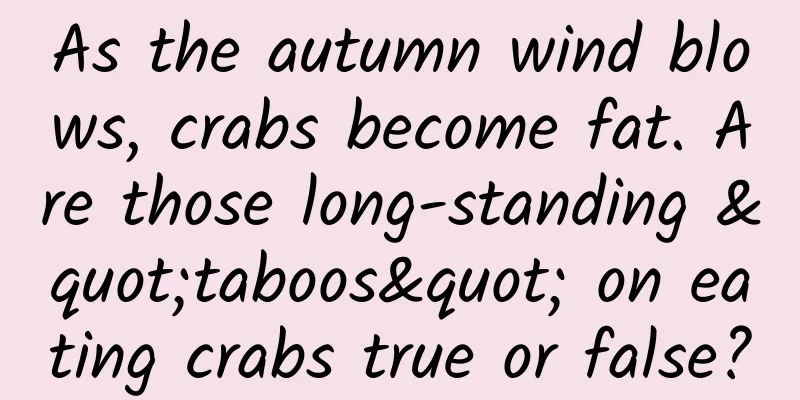As the autumn wind blows, crabs become fat. Are those long-standing "taboos" on eating crabs true or false?

|
As the autumn wind blows, crabs become fatter. Before you happily eat crabs, let’s take a look at the long-standing “taboos” about eating crabs. Which ones are true? Which ones are false? In addition to allergies, there are some other things to be careful about Objectively speaking, except for people who are allergic to crabs, most people can enjoy the delicious crabs as long as they are cooked properly. However, there are a few points that require special attention: Myth 1: "People with gout and high uric acid are not suitable to eat crabs." Correct! People with gout and high uric acid are not suitable to eat crabs, especially crab roe, because of its high purine content. It is even more inappropriate to pair it with beer, sweet drinks, etc., because it will further increase endogenous uric acid. Myth 2: “People with poor digestive function are not suitable to eat too much crab.” Correct! People with poor digestive function are indeed not suitable to eat more crabs, especially not with green tea, because tea polyphenols can reduce the activity of digestive enzymes and cause indigestion. Myth 3: "Eat crabs with rice wine." Moderate amount! Rice wine, ginger and vinegar can remove fishy smells and are often used with seafood. It should be noted that the amount of rice wine used each time is about 50 grams (within 15 grams of alcohol) so as not to exceed the alcohol limit in the dietary guidelines (25 grams for men and 15 grams for women). Myth 4: “You can’t eat raw crabs.” Correct! Raw crabs, drunken crabs, and cooked crabs that have been left out for too long cannot be effectively heated or sterilized, so they can easily be infected with pathogenic microorganisms or parasites and cause diarrhea after being eaten. Myth 5: “Crabs contain excessive amounts of heavy metals.” No basis for this! As for the excessive heavy metals and chemical pollution in crabs, diners can rest assured, because most crabs in China are currently farmed, and the water quality and medication must be tested and qualified, which is more controllable than the wild environment. Even if the waters are polluted, the chemicals are mainly concentrated in the crab gills, crab lungs, crab liver and other inedible parts, so there is no need to worry too much. Myth 6: "Crabs cannot be eaten with persimmons." No basis! Crabs can be eaten with vegetables and fruits such as tomatoes and persimmons. Some people once worried that the vitamin C in vegetables and fruits would convert the organic arsenic in crabs into toxic inorganic arsenic, and reduce the low-toxic pentavalent arsenic to highly toxic trivalent arsenic (i.e. arsenic trioxide). This issue was debunked at the 315 Gala in 2018. At that time, the program team commissioned the Beijing Food Safety Monitoring and Risk Assessment Center to conduct an experiment to simulate the human digestion process after eating crabs and tomatoes together. The results showed that organic arsenic was not converted into toxic inorganic arsenic, especially highly toxic trivalent arsenic. Crabs are delicious, and you can only eat 4 liang of crabs a day. Crabs are rich in nutritional value: High protein: 100 grams of crab meat has a protein content of about 15% to 18% based on fresh weight, which is not as high as the 20% in chicken and beef. However, because crab meat has a high water content and low fat content, its protein content is quite considerable if calculated by dry weight, accounting for 70% to 90% of the dry weight, which is much higher than most foods. Of course, if a large amount of crab meat is consumed at one time, a large amount of protease is also needed to digest it, which will increase the burden on the digestive tract. Rich in magnesium, calcium, zinc, selenium, iodine and other elements. It is worth mentioning that the calcium content in crab meat is higher than that in milk, and some varieties can be as high as 200 mg/100 g; the selenium content is also higher than that in most meats. Rich in vitamin A and vitamin B, crab roe is mainly found in crab roe, in which the vitamin A content can reach 1.5 to 2 times that of eggs. The cholesterol content of high cholesterol sea crabs is 125 mg/100 g, and that of river crabs is 267 mg/100 g, which is higher than meat and close to the level of animal offal such as liver. The cholesterol content of pure crab meat is relatively low (65 mg/100 g), while the cholesterol content of crab roe is very high, so patients with metabolic problems such as hyperlipidemia need to pay attention to their intake. According to the recommendations of the Dietary Guidelines for Residents, the appropriate amount of aquatic products per day is 40 to 75 grams. Converted into crabs, a crab weighing about half a pound has an edible part of about 100 grams. So each of us can eat an average of about 4 taels of river crabs a day. Tips: Four things to look for when choosing crabs In this season, the crab roe is thick and the meat is delicious. However, you need to learn how to choose the crabs. First, look at the crab shell. The meat is more shiny black-green. Don't choose the ones that are black or yellow. Second, look at the belly button. The ones with protruding belly buttons are generally fat and roe-filled. The whiter the belly, the better the quality. The darker the belly, the more polluted the water. Third, look at the crab legs. The ones with dense hairs are better. Choose the ones that feel hard and full. Fourth, look at the vitality. Turn the crab over with its belly facing up. If it can quickly turn back with its legs, it has strong vitality. It is important to remind pregnant women not to eat uncooked crabs, as crabs are more likely to harbor parasites. If they are not cooked well, they can easily be infected with parasites, which can harm the fetus and cause miscarriage. In addition, avoid eating crab gills, crab stomach, crab intestines, and crab heart, which are more likely to have bacteria, to prevent food poisoning. |
>>: What do swans eat? The meaning and symbolism of swans
Recommend
Can I eat sour pears during menstruation?
Sour pears are a favorite of many people. You can...
Why does a pregnant woman retch but not vomit?
Many pregnant women experience nausea during preg...
Normal values of six estrogen test items
Since the female body has to complete the task of...
What are the fun attractions in Sanya? What should I wear in Sanya in March?
Sanya Betel Nut Valley is located in Ganshiling N...
My period was delayed for 5 days and the bleeding disappeared
What is the reason why menstruation is delayed fo...
Why is there brown in leucorrhea
Many female friends come to us for consultation, ...
What are eggs like?
Eggs are mainly some female reproductive cells, a...
What to eat after cervical cancer surgery
The problem of cervical cancer is quite serious. ...
What are the symptoms of menopause in women?
For women, the biggest worry is entering menopaus...
What is the cause of moderate cervical erosion?
Being a woman is a very painful thing, because a ...
One month pregnant, stomach pain
In the early stages of pregnancy, many people wil...
What to do if you have a cyst on your left ovary during pregnancy
Having a left ovarian cyst during pregnancy is a ...
What medicine should I use if there is a strange smell down there
The main reason for the fishy odor in women's...
Mixpanel: As of April 2021, the overall usage rate of iOS 14 reached 90%
Less than seven months after the release of iOS a...
Leaking urine when coughing? This "embarrassing" disease is ignored by many people...
Expert of this article: Zhu Hongjian, Chief Physi...









